At dawn on Nov. 20, 1943, off Makin Atoll in the Gilbert Islands, a task force of U.S. Navy battleships, cruisers and destroyers moved into position for pre-invasion bombardment while transports carrying soldiers of the 165th Regimental Combat Team (RCT) sailed quietly into their assigned areas off Makin’s main island, Butaritari, at the southern edge of the atoll. Their mission: to capture the atoll from the Japanese for use as a base during future attacks on the nearby Japanese-held Marshall Islands.
On Dec. 10, 1941, three days after the Japanese attack on Pearl Harbor, 300 Japanese troops plus laborers of the so-called Gilberts Invasion Special Landing Force had arrived off Makin and occupied it without resistance. Lying east of the Marshall Islands, Makin would make an excellent seaplane base, extending Japanese air patrols closer to Howland Island, Baker Island and Ellice Islands–all held by the Allies–and protecting the eastern flank of the Japanese perimeter from an Allied attack.
After the invasion, the Japanese began constructing a seaplane base and coastal defenses on Makin. Before long, most of the assault troops were pulled out of Makin and sent to places where they were needed. By August 1942, Makin’s garrison consisted of 43 men commanded by a warrant officer.
On Aug. 17, 1942, 221 Marines of the 2nd Marine Raider Battalion, under Col. Evans Carlson, landed on Makin from the submarines Nautilus and Argonaut. The Marines scattered the garrison, destroyed some aviation fuel and secured vital papers before they withdrew, losing 21 men.
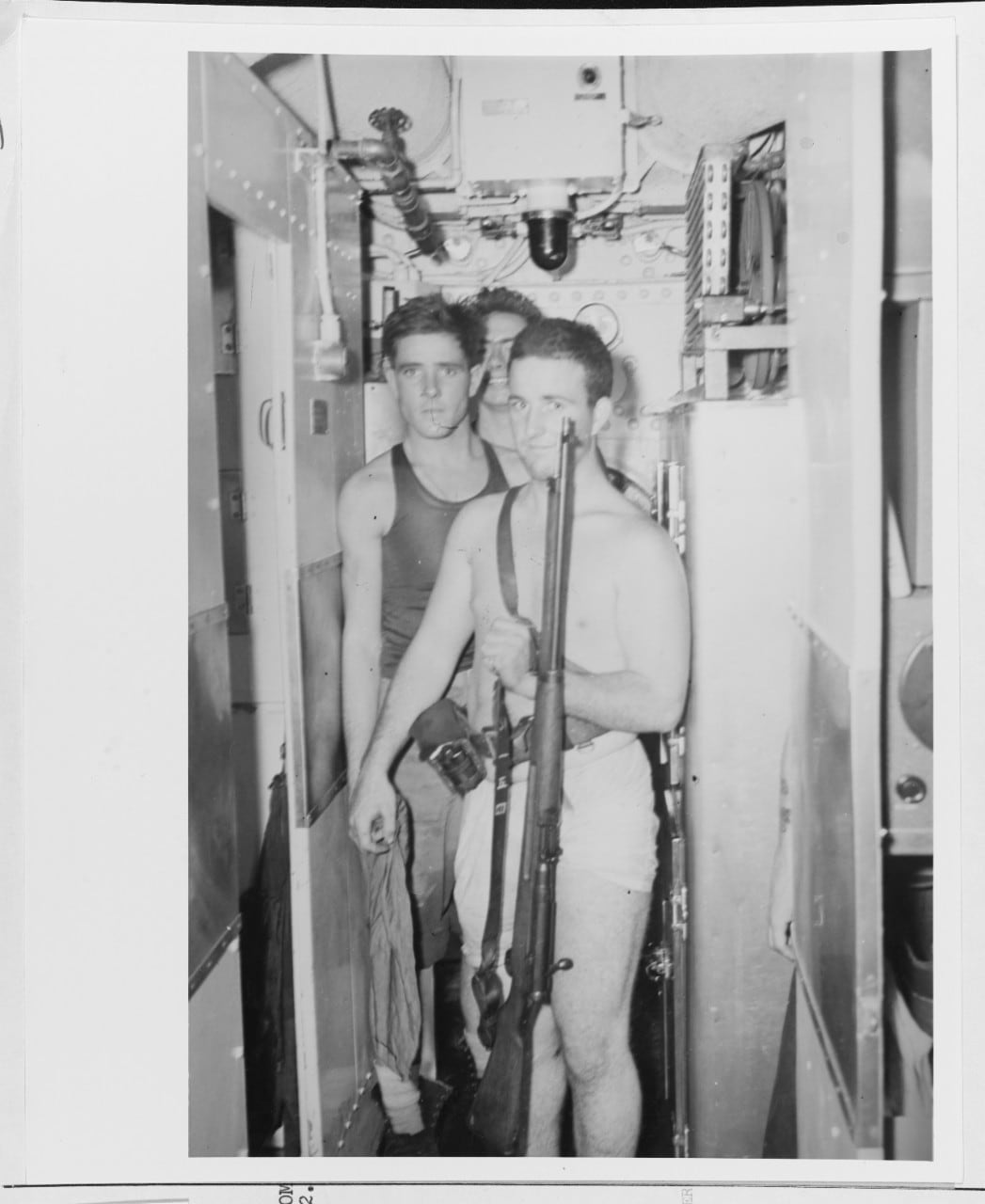
After Carlson’s raid, the Japanese reoccupied the Gilberts, which had been left lightly guarded, in force. Makin was garrisoned with a single company of the 5th Special Base Force on Aug. 30, 1942, and work on both the seaplane base and coastal defenses of the atoll was resumed in earnest.
By July 1943, the seaplane base on Makin was completed and ready to accommodate Kawanishi H8K2 (“Emily”) reconnaissance and Mitsubishi A6M2-N (“Rufe”) fighter seaplanes. Its defenses were also completed, although they were not as extensive as those on Tarawa Atoll, the main Japanese air base in the Gilberts.
While the Japanese were building up their defenses in the Gilberts, American forces were making plans to retake the islands.
In June 1943, the Joint Chiefs of Staff directed Adm. Chester W. Nimitz, commander in chief of the Pacific Fleet (CINCPAC), to submit a plan to occupy the Marshall Islands.
Initially both Nimitz and Adm. Ernest J. King, the chief of naval operations, wanted to attack right into the heart of the Japanese outer defense perimeter. But any plan for assaulting the Marshalls directly from Pearl Harbor would have required more troops and transports than the Pacific Fleet had at that time.
Considering these drawbacks, and the U.S. forces’ lack of experience in amphibious operations, King and Nimitz decided to take the Marshalls in a step-by-step operation via the Ellice and Gilbert islands.
The Gilberts lay within 200 miles of the southern Marshalls and were well within range of U.S. Army Air Forces (USAAF) aircraft based in the Ellice Islands, which could provide bombing support and long-range reconnaissance for operations in the Gilberts.
With those advantages in mind, on July 20, 1943, the Joint Chiefs of Staff decided to capture the Tarawa and Abemama atolls in the Gilberts, plus nearby Nauru Island.
The operation was code-named ‘Galvanic.’
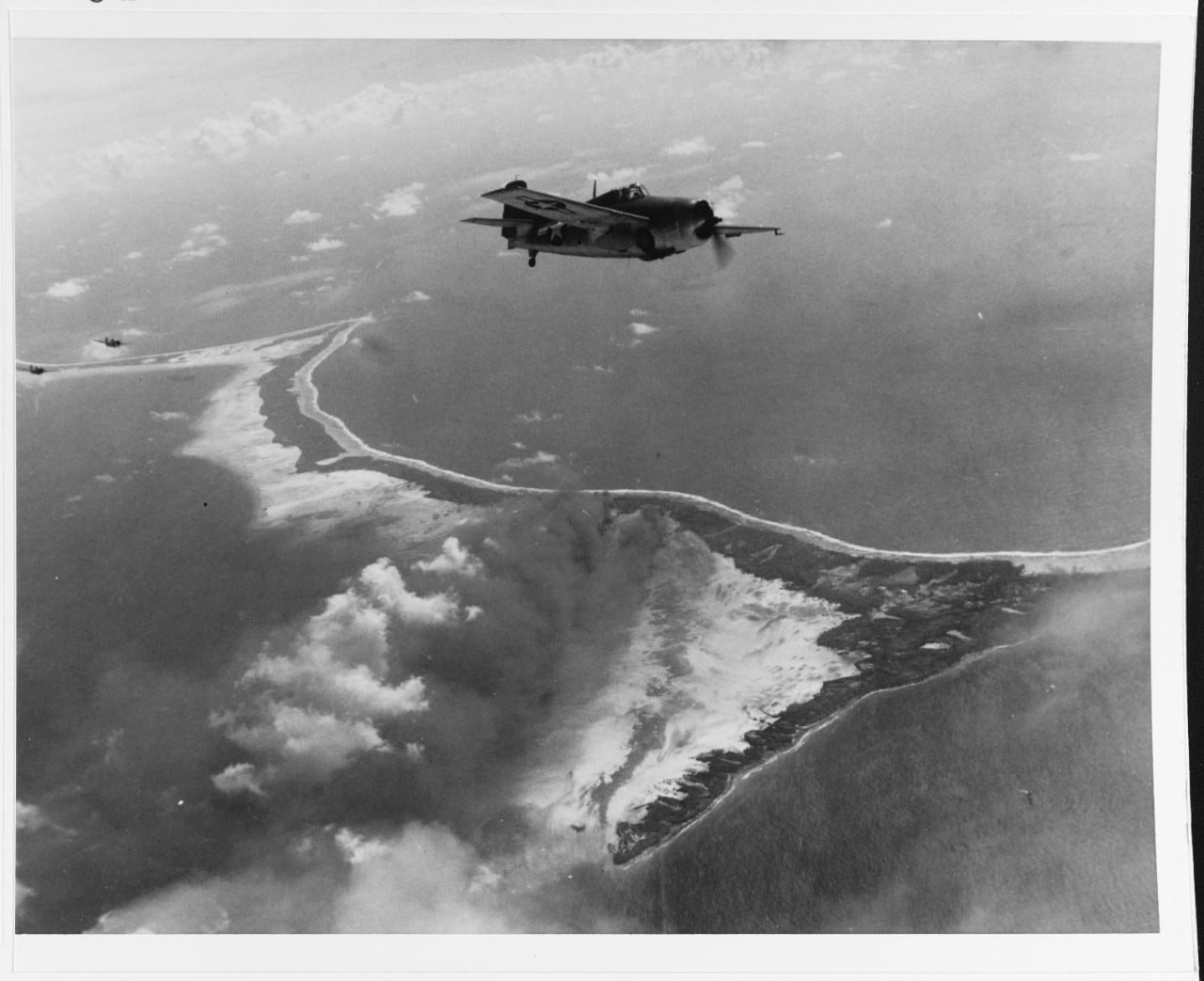
On Sept. 4, 1943, the Fifth Fleet’s amphibious troops were designated the V Amphibious Corps and placed under Maj. Gen. Holland M. Smith, U.S. Marine Corps. The V Amphibious Corps had only two divisions, the 2nd Marine Division based in New Zealand and the U.S. Army’s 27th Infantry Division based in Hawaii.
The 27th Division had been a New York National Guard unit before being called into federal service in October 1940. It was transferred to Hawaii and remained there for 1 1/2 years before being chosen by Lt. Gen. Robert C. Richardson, the U.S. Army’s commanding general in the Central Pacific, to take part in the Gilbert Islands invasion.
The 27th Division had 16,000 men in three regiments–the 105th, 106th and 165th Infantry regiments, plus the 105th Field Artillery Battalion and the 193rd Tank Battalion, along with supporting units. Its commander was Maj. Gen. Ralph Smith, a veteran of World War I who had assumed command in November 1942. He was one of the most highly respected officers in the U.S. Army.
In April 1943, the 27th Division had begun preparing for amphibious operations. Between May and August 1943, each battalion landing team in the division was assembled at Schofield Barracks on Oahu and instructed in the use of ropes, cargo net climbing, boat team drill, disembarking from mock-up assault craft and other techniques of amphibious warfare.
After Schofield Barracks, each battalion received a week’s instruction at the Waianae Amphibious Training Center, where a pier simulated a naval transport, and a specially constructed barge anchored offshore was used to give the troops experience in debarking from a listing vessel.
The prospect of actual combat encouraged intensive training. Tropical hygiene and other skills for living in the jungle were studied. Tank, artillery and infantry units took part in platoon, company, battalion and regimental field exercises. The troops practiced attacks in jungle terrain, night operations, attacking fortified jungle positions, and the elimination of Japanese snipers.
Only one problem was found in the 27th Division’s training program.
“No systematic training of army tanks in conjunction with small infantry units was attempted,” an Army historian wrote. ‘"n view of the importance of a smoothly functioning tank-infantry team in the forthcoming operation, the omission was serious."
While the men trained, planning for the landing operation continued. Planning for the 27th Division’s role in Operation Galvanic (the Army portion was code-named “Kourbash”) began in early August 1943, with Nauru Island in the western Gilberts as the original objective.
In September 1943, however, the 27th’s target changed. Analysis of the problems involved in capturing Nauru at the same time as Tarawa and Abemama, plus Holland Smith’s doubts about the green 27th Division’s ability to take the heavily defended island, caused Adm. Nimitz to shift the 27th’s target from Nauru to Makin, in the northern Gilberts.
The 27th Division’s staff learned of the change of target on Sept. 28, 1943, scrapped the original Nauru plan, and began planning to capture Makin.
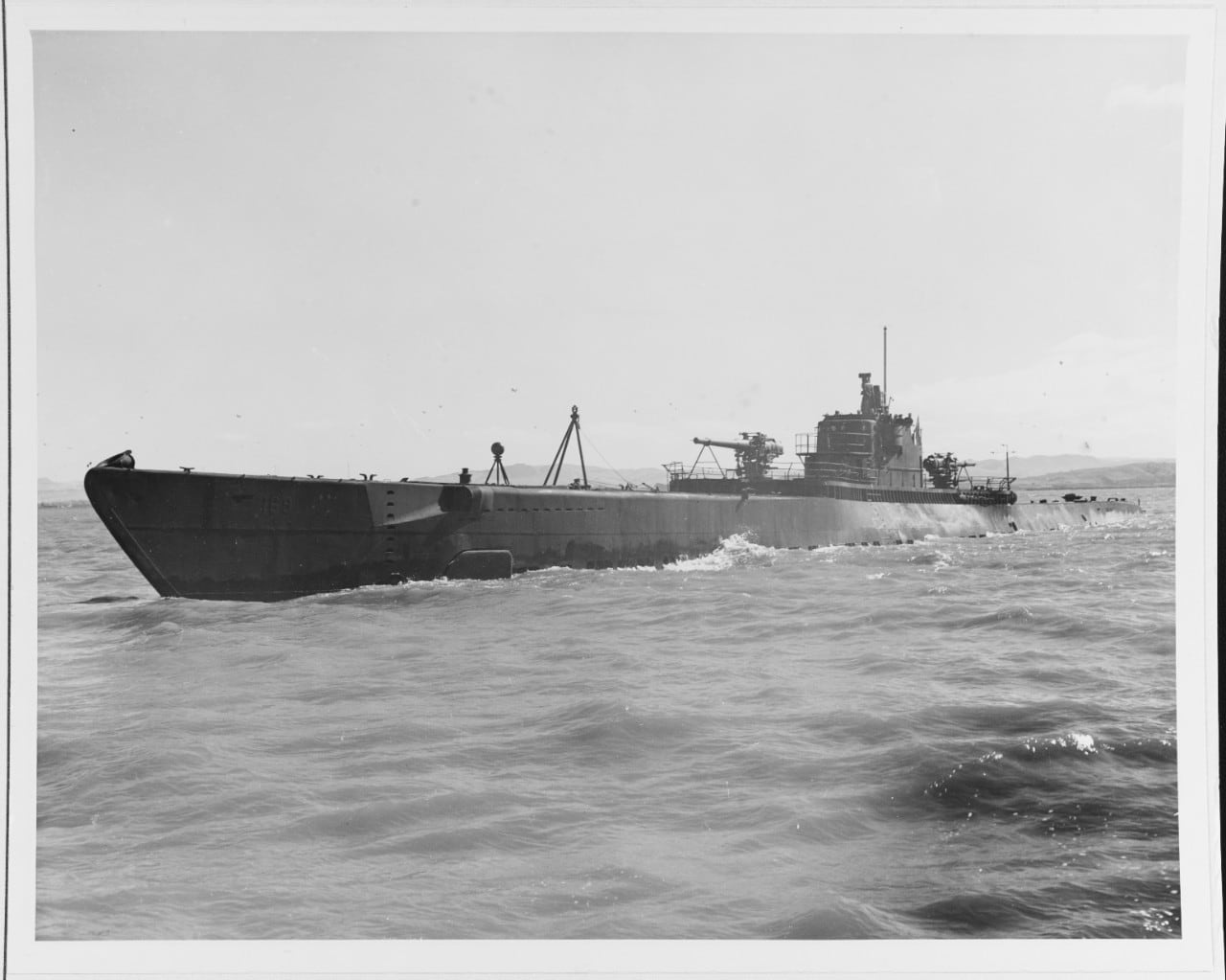
They had six weeks to collect intelligence on Makin and incorporate it in the revised landing plan. The submarine Nautilus, with the 27th’s assistant Intelligence officer, Capt. Donald N. Neuman, aboard, cruised around Makin in early October 1943 photographing the west and south shores of Butaritari Island through the periscope.
Pictures taken by 7th Air Force photo flights, along with those taken during U.S. carrier-based air attacks on the Gilberts in September 1943, were used to establish the strength and position of Japanese defenses on Butaritari.
The report of Carlson’s raiders and information from two former Makin residents, Lt. Cmdr. Heyen of the Royal Australian Navy and Pvt. Fred C. Narruhn of the 1st Fiji Infantry, provided more useful information. Using those new sources, improved plans were devised to fit the conditions at Makin.
The 165th Infantry Regiment, commanded by Col. Gardner J. Conroy, was chosen to make the assault. It was reinforced by a detachment from the 105th Infantry, two tank companies of the 193rd Tank Battalion and three batteries of the 105th Field Artillery Battalion — a total of 6,470 officers and enlisted men.
Following shore-based training, the 165th conducted joint amphibious training on beaches in the Hawaiian Islands.
The first rehearsal was held in Maalaea Bay, Maui, on Nov. 1, 1943, with simulated naval gunfire and air support. A full-scale landing rehearsal was held off Kahoolawe Island at dawn on Nov. 3, using live naval gunfire and air support, coordinated by fire control parties ashore.
Assault troops were loaded on landing craft and taken to the line of departure but did not land, because Kahoolawe’s rocky beaches were unsafe for landing craft. The transports then returned to Pearl Harbor for final briefing, repairs and loading before sailing to Makin with Rear Adm. Richmond Kelly Turner’s Northern Attack Force.
On Nov. 10, with Col. Conroy’s troops and equipment loaded aboard transports Leonard Wood, Neville, Alcyone, Pierce, Calvert and the LSD (landing ship, dock) Belle Grove, the Northern Attack Force left Pearl Harbor for the Gilberts. During the 10-day voyage to Makin, the troops were briefed on their target and the attack plan. When they were not in briefings, the men passed the time as best they could on board the crowded transports.
“About all that can be said is that by the time they departed for Makin, the first strangeness had worn off, the men were no longer prone to sea-sickness, and they were reasonably content,” Army historian S.L.A. Marshall wrote.
“However, it is to be noted that for the first five or six days most of the personnel were tense. What changed all this was the experience of crossing the equator and the full day and a half of horse play attendant thereto. From that time onward, one senses a completely different attitude on the part of officers and men.”
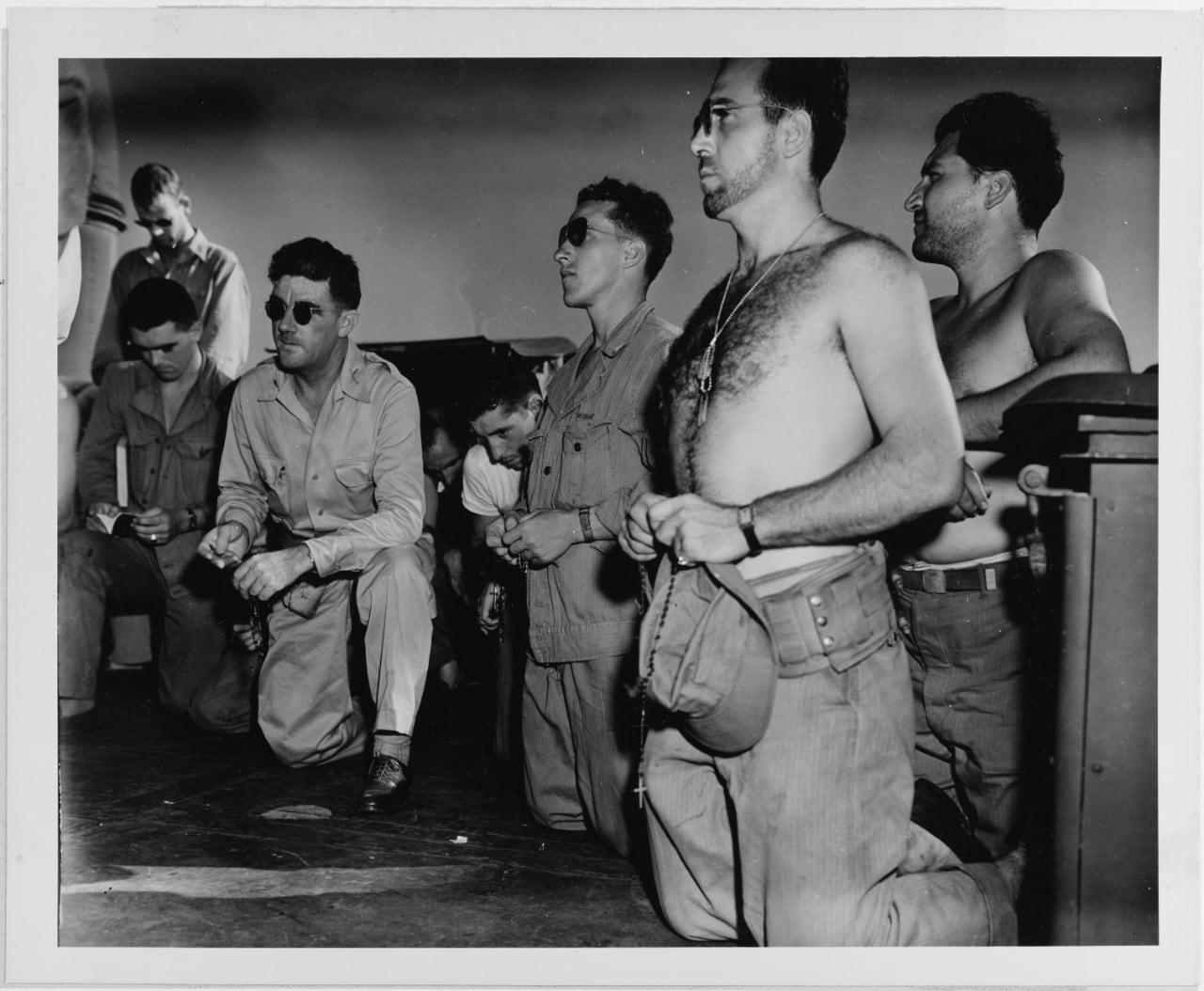
While the 27th Division’s soldiers were sailing on crowded troop transports for their first major amphibious operation, the Japanese on Makin were waiting for them. Heavy aircraft losses and the sinking of four heavy cruisers in the Solomons meant that the original Japanese plan of a strike at the American invasion fleet by forces based at Truk in the nearby Caroline Islands was scrapped. The garrisons at Tarawa and Makin were left to their fate.
On the eve of the invasion, the Japanese garrison on Makin Atoll’s main island, Butaritari, consisted of 798 men: 284 troops of the 3rd Special Base Force-Makin Detachment, 100 aviation personnel, 138 members of the 11th Construction Unit and 276 men of the 4th Fleet Construction Unit, all commanded by Lt. j.g. Seizo Ishikawa.
Most of the aviation and labor troops had no combat training and were not assigned weapons or a battle station. The number of actual combat troops on Makin was no more than 300 men.
Butaritari’s defenses were centered around the lagoon shore near the seaplane base in the central part of the island. There were two tank barrier systems. The west tank barrier, which extended from the lagoon two-thirds of the way across Butaritari, was 12 to 13 feet wide and 5 feet deep, and was protected by one anti-tank gun, a concrete pillbox, six machine-gun positions and 50 rifle pits.
The east tank barrier, 14 feet wide and 6 feet deep, stretched from the lagoon across two-thirds of the island and bent westward with log anti-tank barricades at each end. It was protected by a double apron of barbed wire and an intricate system of gun emplacements and rifle pits.
A series of strong points was established along Butaritari’s ocean side, with 8-inch coastal defense guns, three 37mm anti-tank gun positions, 10 machine-gun emplacements and 85 rifle pits.
The Japanese expected an invasion to come on the ocean side of Butaritari, following the example of Carlson’s raid in 1942, and established their defenses two miles from where that raid had taken place. Without aircraft, ships or hope of reinforcement or relief, the outnumbered and outgunned defenders could only hope to delay the coming American attack for as long as possible.
While the fire support ships moved into position off Butaritari on Nov. 29, 1943, the transport Leonard Wood arrived off the western landing beaches at 0603 and began lowering her assault boats in the stillness. The transports Neville, Alcyone and Pierce, carrying the rest of the 165th RCT, followed and began lowering their assault craft and embarking their troops. The stillness did not last long. At 0610, carrier-based fighters and dive bombers attacked targets all over Butaritari Island, bombing and strafing the landing beaches.
After the air attacks were finished at 0640, 14- and 8-inch guns from the fire support battleships and cruisers opened fire on the island. While the fire support ships pounded Butaritari, the troops debarked.
“In the early morning light they climbed down rope cargo nets into the waiting LCVPs [landing craft, vehicle and personnel],” an Army historian wrote. “As soon as each craft had received its allotted quota of men…it moved off…and joined other small boats circling in the assembly area.’ Two LSTs (landing ship, tank) launched 16 amtracs (amphibious tractors), each ‘like small fish swimming out of a whale’s mouth.”
The amtracs, carrying the first wave’s troops, joined the LCVPs circling and waiting for the signal to approach the beaches. Their targets were two beaches on the western side of Butaritari, a hammer-shaped island with Flink and Ukiangong points forming the head of the hammer.
Between them were Red Beach and Red Beach 2, where Lt. Col. Gerard W. Kelley’s 1st Battalion and Lt. Col. Joseph Hart’s 3rd Battalion were to land.
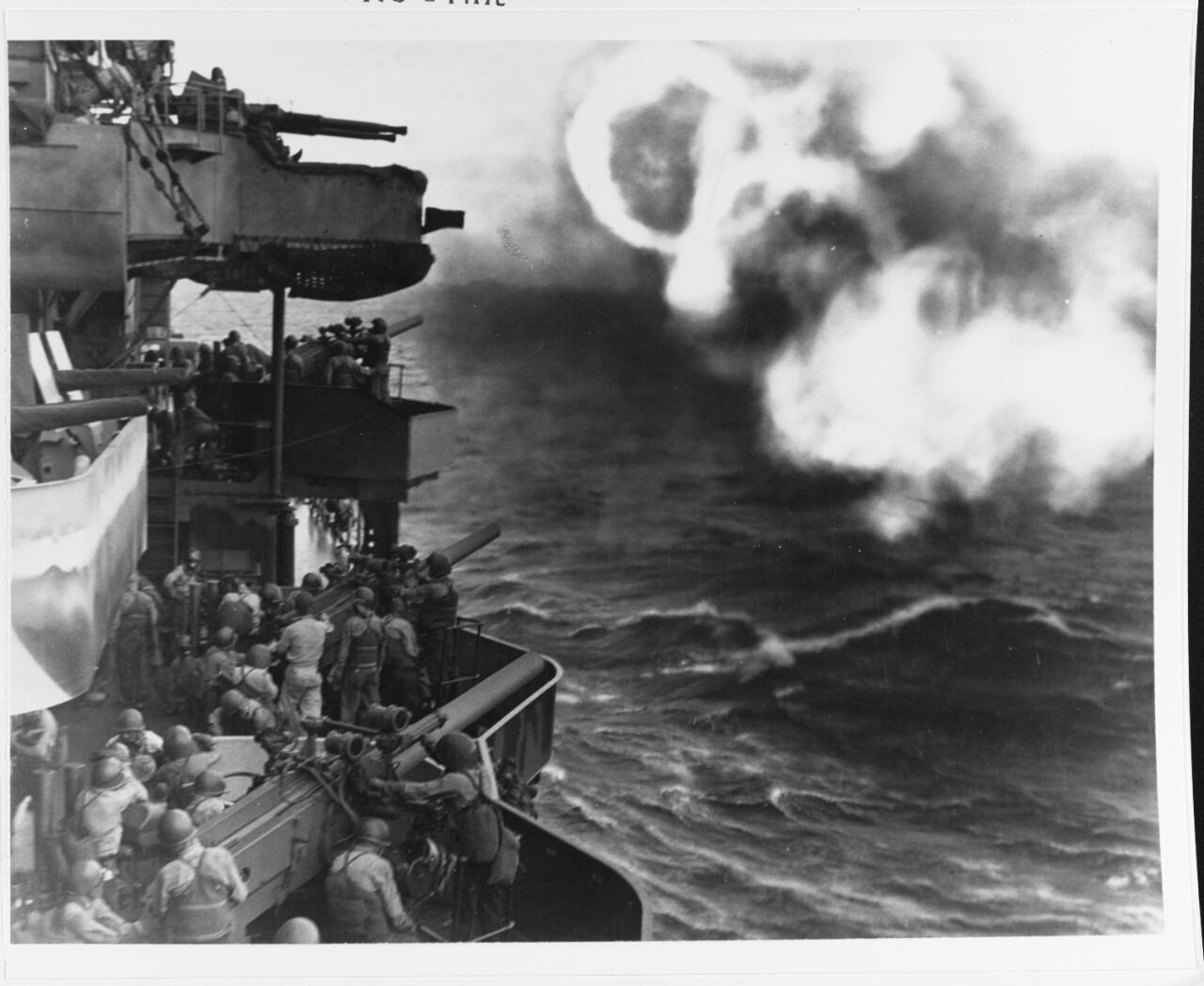
At 0750, the order was given to move to the line of departure. The first wave moved past the line toward the island at 0813, and as it approached the shore the amtracs opened fire with their .50-caliber machine guns. There was no return fire.
At 0831, the amtracs crawled up the landing beaches. The first-wave troops scrambled over the amtracs’ sides.
“I jumped down from my boat,” one officer recalled, “and stood straight for two or three minutes, waiting for somebody to shoot me. Nobody shot. I saw many other soldiers doing the same thing.”
Following the amtracs came the first three waves of landing craft, scheduled to put 460 men and eight tanks onto the Red beaches. Coming in on a rising tide, some landing craft were able to slip past the coral reef and get to within a boat’s length (36 feet) of the beach.
But many landing craft were stranded on the reef or forced to put out to sea again. Tanks, waterproofed for the landing, rolled off the landing craft into the water and struggled toward the beach. Infantry slogged ashore in high swells, stumbling over rocks and boulders before reaching the beaches.
The amtracs that carried the first wave ashore were pressed into service unloading the boats stranded on the reef, ferrying their cargoes ashore.
Those conditions threw the carefully rehearsed landing schedule into confusion. Only three boats at a time were able to get ashore, and the fifth assault wave landed more than an hour behind schedule.
While the follow-up waves were trying to get off the beaches, the men of the 1st Battalion moved inland. They met with slight resistance but were slowed by thick vegetation and craters left from the air and naval bombardment.
By 1030, the 1st Battalion had penetrated 1,300 yards inland, and its A Company was halfway up Flink Point, which was secured by 1240.
The 3rd Battalion on its right flank made rapid progress in an area it had believed would be heavily defended, taking Ukiangong Village and Ukiangong Point without resistance by 1040, while its K Company advanced farther into Butaritari.
Two hours after the landing, a unit of K Company met the first serious resistance, and five Japanese soldiers were killed. K Company made contact with the 1st Battalion at 1055.
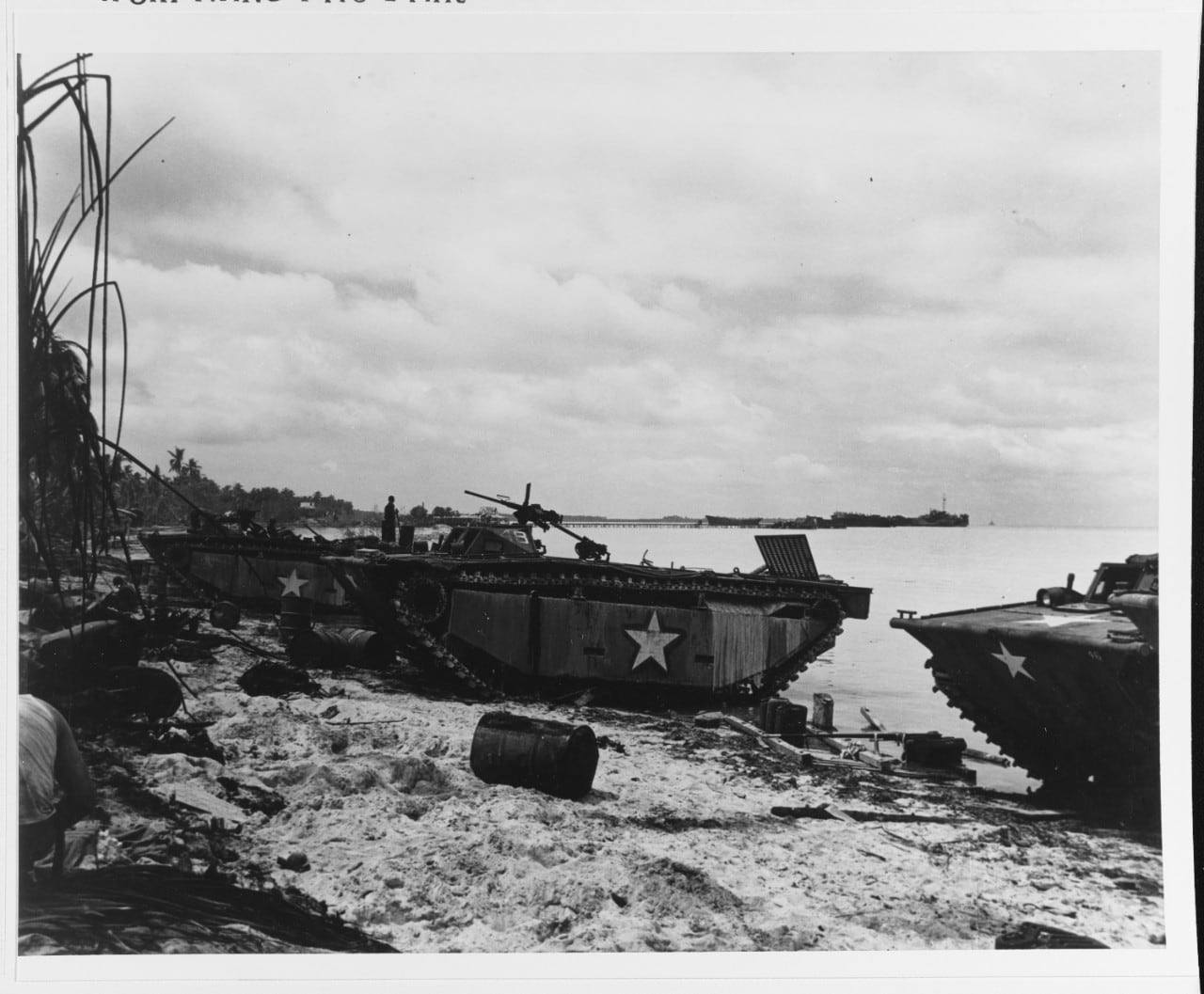
While the 1st and 3rd battalions cleared Flink and Ukiangong points, the second half of the attack plan went into action. The overall plan called for two battalions to land on the Red beaches and draw the Japanese defenders out of the citadel area in the center of Butaritari, where they would be attacked in flank and rear by a landing force coming from the island’s lagoon side.
At 0800, a naval task unit consisting of the transport Neville, LSD Belle Grove and LST-179 began moving into Makin Lagoon. On board the transports were troops of Lt. Col. John F. McDonough’s 2nd Battalion, along with Company A of the 193rd Tank Battalion and Detachment Z of the 105th Infantry. Their objective was Yellow Beach, which lay between On Chong’s Wharf and King’s Wharf on Butaritari’s north side.
At 0830, LST-179 launched its amtracs with the initial assault wave on board. The first wave consisted of 16 amtracs, followed by the second and third waves of LCMs (landing craft, marine) carrying M-3 General Lee medium tanks. The fourth wave had two troop-carrying LCVPs and four LCMs with M-3 General Stuart light tanks. The next waves were of LCVPs carrying the rest of the 2nd Battalion.
‘The first wave headed towards Yellow Beach,’ an Army officer wrote. ‘The boats moved calmly in. Some of the men read magazines….Although there was singing all along the line of landing craft, a few men fell asleep. Others were eating cold lunches and horsing around all the way in.’
At 1025, with the first wave 600 yards off the beach, naval gunfire was lifted to allow a last-minute strafing run by carrier planes. When the planes neared the beach, the lead amtracs slowed down for fear of coming under fire from the planes.
The following waves also slowed down, setting back the landing schedule by 10 minutes. As the assault waves continued toward shore, they came under enemy fire 500 yards from the beach. Most of the firing came from two half-sunken hulks in the lagoon and from On Chong’s and King’s wharves.
Under a cross-fire, the men hunched low in their amtracs during the last 300-yard run into the beach.
“With naval gunfire exploding ammunition and fuel depots on the shore, planes strafing and bombing the beach, the alligators [amtracs] firing their rockets and machine guns,” Col. McDonough wrote, “it was almost impossible for anyone to certify just where the enemy fire was coming from.”
The first waves went ashore on Yellow Beach at 1041 and began moving inland. King’s Wharf fell without resistance.
On Chong’s Wharf was taken after some resistance by Japanese troops. Thirty-five prisoners, mostly Korean laborers, were captured.
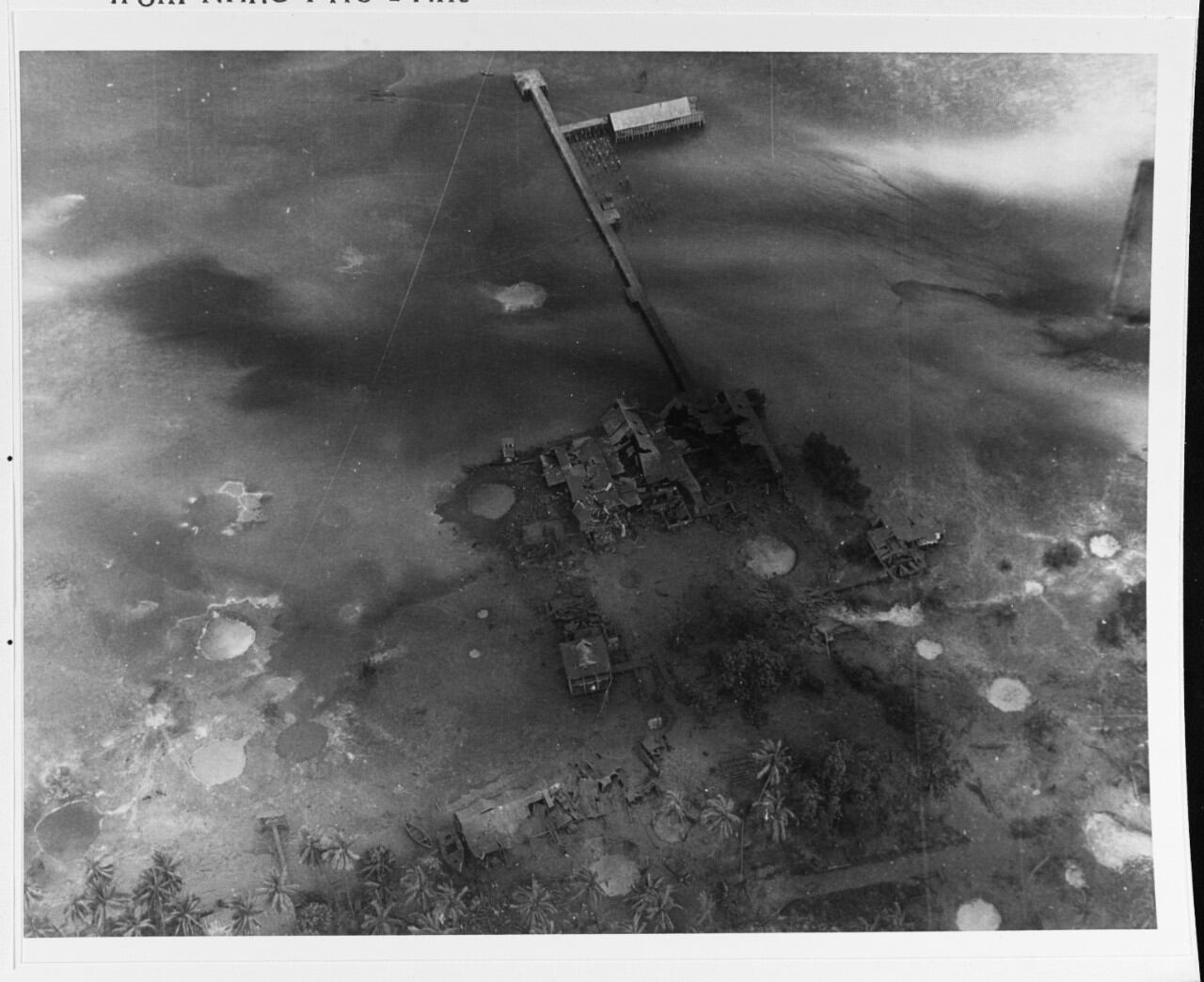
As at the Red beaches, the medium Lee tanks of Capt. Robert S. Brown’s A Company, 193rd Tank Battalion, had to roll from their LCMs in 2 to 3 feet of water before reaching the beach. All but two of A Company’s 15 tanks reached shore safely. Both of those, which included Capt. Brown’s, foundered in shell holes on the reef.
“We went forward about 25 yards and hit a shell hole,” a sergeant commanding one of the sunken tanks recalled. “We got out of that and went about 15 yards and hit another. The water was about 7 feet deep and our tank drowned out.”
Behind the tanks came the fourth and fifth waves in LCVPs, which grounded like the LCMs on the reef. The men debarked into knee-deep water and waded ashore under heavy Japanese fire. Most of the fire was aimed low in the water, however, and was not accurate. Only two men were killed in the fourth and fifth waves; none were wounded. Japanese fire from the hulks was soon eliminated by naval gunfire and airstrikes.
Once the 2nd Battalion’s troops and tanks were ashore, they deployed to carry out their objectives.
E Company moved east across Butaritari and established a line near the east tank barrier to guard against possible Japanese attack. Two platoons from E and F companies struck out across the island against scattered Japanese resistance, reaching the ocean side shortly before noon. The rest of F Company, supported by eight M-3 Lee tanks, moved west of On Chong’s Wharf and reached the west tank barrier at 1130.
While the 2nd Battalion was moving across Butaritari from Yellow Beach, Col. Kelley’s 1st Battalion moved toward them from the west, following a plantation road east through coconut groves, halting to shoot at snipers. Japanese snipers had cached rifles and gourds of sake in the fronds of certain trees, where a rifleman could climb and wait for targets. But they did not hold up the 1st Battalion’s advance for very long.
By 1400, the troops had reached the second-phase line but were delayed by a huge shell crater on the roadway, which bogged down the leading tank and created a roadblock. The road was surrounded by marsh and jungle, preventing the other tanks from bypassing the first one.
While the 1st Battalion’s right flank companies made rapid progress, C Company, on the left flank, ran into difficulty when it encountered a Japanese machine-gun nest concealed by a natural dip in the terrain and protected by snipers hidden in the surrounding trees.
A few Stuart tanks of Company C, 193rd Tank Battalion, which could have reduced the Japanese position in a few minutes, were present, but their drivers would only take orders from their commanding officer back at the Red beaches; C Company’s infantry had no way to communicate with him.
Hearing about the delay, Col. Kelley decided to order C Company to bypass the Japanese position, leaving its support platoon to reduce it, and continue the advance. On his way to give C Company’s commander, Capt. Charles E. Coates, Jr., his orders, Kelley was pinned down by Japanese fire, along with the regimental chaplain, Joseph A. Meaney.
While Col. Kelley was pinned down, Col. Gardner J. Conroy, convinced that only a few Japanese were holding up C Company, came walking into the area. Seeing Conroy, Kelley yelled for him to get down. Conroy hesitated and was killed instantly by a bullet between his eyes. Kelley took command of the 165th Infantry, while Maj. James H. Mahoney, the executive officer of the 1st Battalion, assumed command of the battalion.
The light tanks brought forward by Col. Conroy retired on Kelley’s orders without firing a shot because of the danger of hitting friendly troops. Mortar and machine-gun fire were withheld for the same reason.
C Company bypassed the Japanese position and advanced to the edge of the west tank barrier, while follow-up companies moved up behind them. By 1755, the 1st and 2nd battalions had made contact along the west tank barrier.
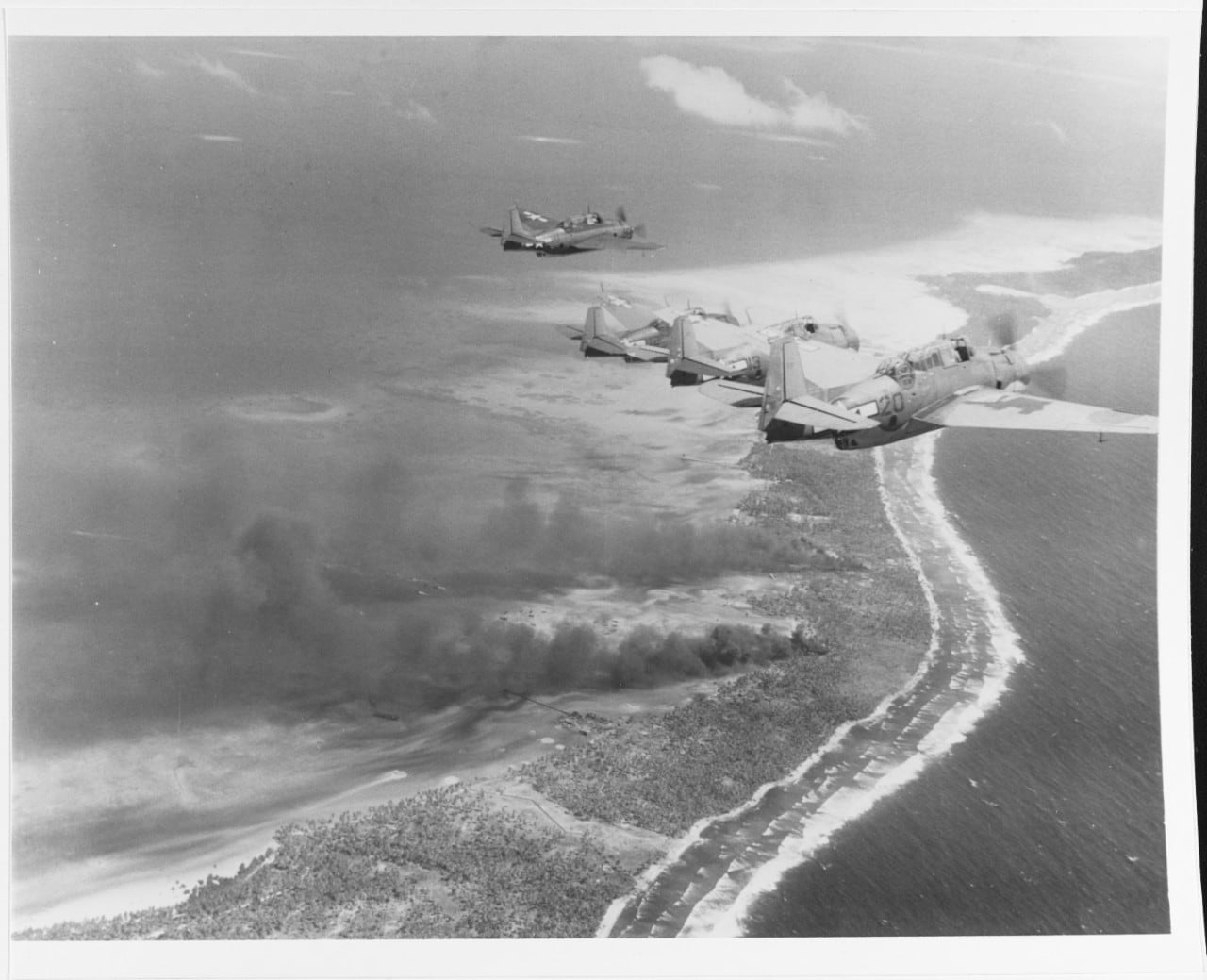
By the end of the first day’s fighting, the 165th had established a firm foothold on Butaritari.
The 1st Battalion held the entire area from Red Beach and Red Beach 2 to the west tank barrier, except for a small pocket contained by C Company northwest of the barrier.
The 2nd Battalion held the center of the island from Yellow Beach to the west tank barrier and across the island to the ocean. The 3rd Battalion assembled southwest of one of Butaritari’s freshwater lakes after its relief by the 1st Battalion and dug in there for the night.
As planned, all three batteries of the 105th Field Artillery were in position on Ukiangong Point and had fired their 105mm howitzers in support of the 2nd Battalion.
Total American casualties for the first day were 25 killed and 62 wounded. The Japanese lost 50 dead and 41 wounded.
As the sun went down, the attack was halted by order of Maj. Gen. Ralph Smith, who had come ashore at 1800 to establish the 27th Division headquarters in the 165th Regiment’s command post. The troops dug in for the night, anticipating a Japanese attack.
For the Americans, the first night on Butaritari was a long one. The Japanese kept up sniper fire, set off firecrackers to draw American fire, and called out in garbled English. Green troops, nervous in their first battle, peppered away indiscriminately at unseen targets, wasting ammunition and drawing Japanese fire.
The worst such incident happened after daybreak when a soldier from A Company, 152nd Engineers, ran along the lagoon shore shouting, “There’s a hundred and fifty Japs in the trees!”
Hearing this, many soldiers began shooting wildly into the trees. The engineer then admitted that he had not seen any Japanese but had only heard firing. It took direct orders from officers to make the men cease firing.
As the Army history of the Makin operation put it, “The harassing tactics of the enemy were to this extent effective.”
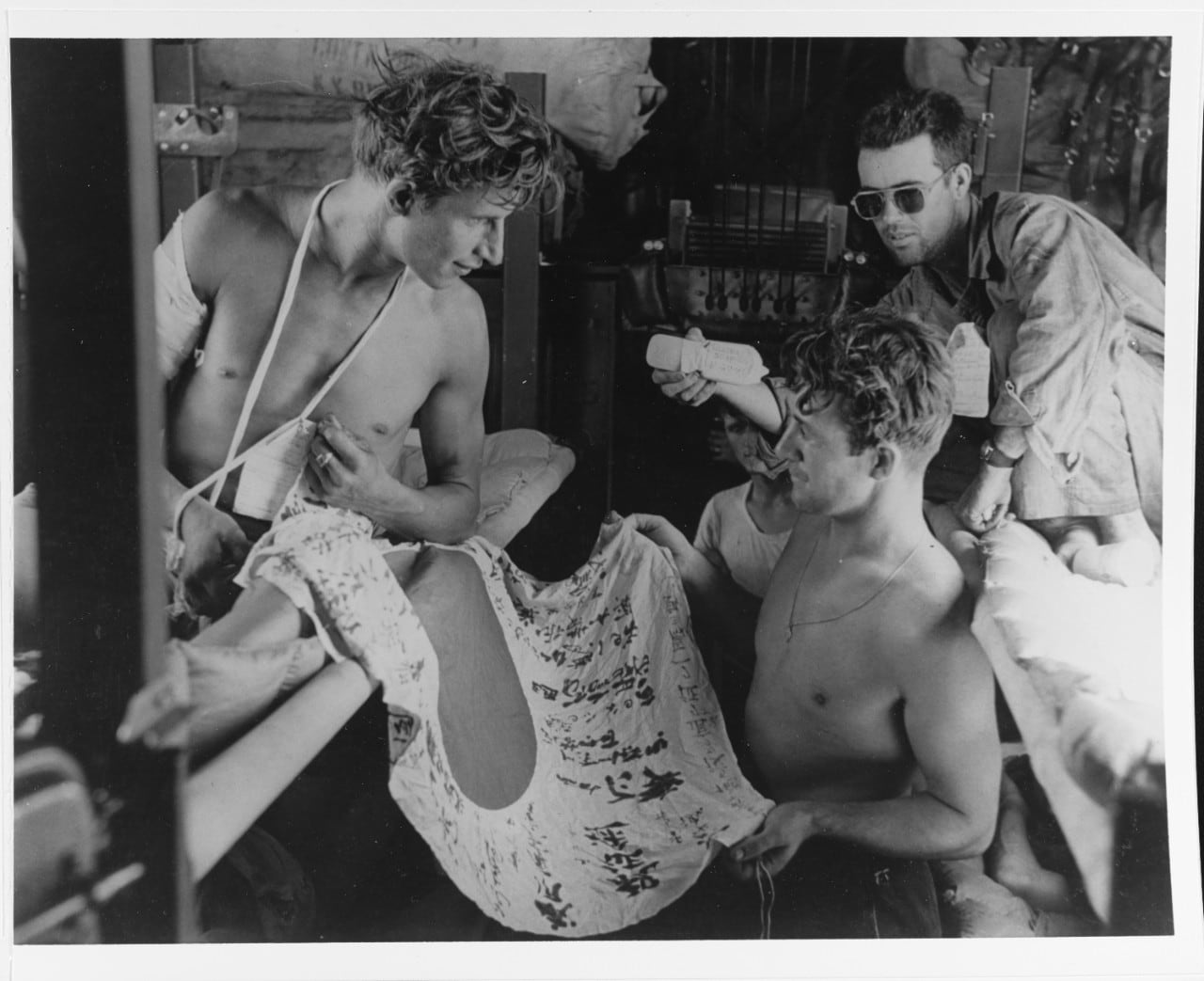
When the sun rose over Makin on the morning of Nov. 21, 1943, the Americans faced the problems of eliminating the Japanese pocket near the west tank barrier, clearing the approaches to Yellow Beach, where the Japanese were supposed to have occupied two partially sunken vessels near On Chong’s Wharf, and securing the rest of Butaritari.
Starting at 0818, while the landing craft stayed clear, airstrikes were made on the hulks. They were also shelled by 75mm sponson guns on the M-3 Lees. Some of the shells overshot the vessels and fell into the lagoon near the landing craft. In late afternoon, a 16-man detail headed out to the hulks in two amtracs to eliminate any Japanese on them.
They found no Japanese on the hulks, and the landing craft began unloading on Yellow Beach again.
The 1st Battalion’s troops were also clearing the pocket northwest of the west tank barrier. The heaviest fighting took place in a coconut grove in the middle of the island, where a group of Japanese fired on a platoon mopping up a former stronghold. Four Stuart tanks assisted the infantry by spraying the treetops with .30-caliber machine-gun fire and 37mm canister shells.
The four tanks had been firing for five minutes when a Navy dive bomber, its pilot mistaking the west tank barrier for the Japanese-held east tank barrier, dropped a 2,000-pound bomb near them.
The tank officer in charge, 1st Lt. Edward J. Gallagher, was killed along with two enlisted men, and several others were injured. When the Stuart crews recovered from the shock and concussion, the Japanese had gone. The action at the west tank barrier was over, and no more trouble with Japanese stragglers in that area was encountered.
The 165th shifted its full attention to securing the remainder of Butaritari Island. The main action began at 1110, when 2nd Battalion’s E and G companies, a detail of Marines from the V Corps amphibious reconnaissance company, Detachment Z of the 105th Infantry and 10 Lee tanks moved into eastern Butaritari after attacks by carrier-based planes on Japanese positions were completed.
The troops and tanks advanced slowly but steadily through the vegetation, averaging three yards a minute. A few snipers were encountered, but they did not delay the advance.
“On the second day we did not allow sniper fire to deter us,” 1st Sgt. Thomas E. Valentine of E Company later said. “We had already found that snipers were used more as a nuisance than an obstacle….We learned that by taking cover and moving rapidly from one concealment to another we could minimize the threat. Moreover, we knew that our reserves would get them if we could not.”
Between noon and 1400, the three companies and their supporting tanks passed through the most heavily defended area on Butaritari, encountering machine guns, barbed wire and emplacements made of coconut palm logs that resisted even direct 75mm gunfire.
The American infantry had no room to maneuver on long, narrow Butaritari and had to slug its way forward on a front barely 300 yards wide in places. Jammed into a narrow area, the troops could not call on naval gunfire or even their own field artillery’s 105s on Ukiangong Point.
The fighting was bunker to bunker, pillbox to pillbox.
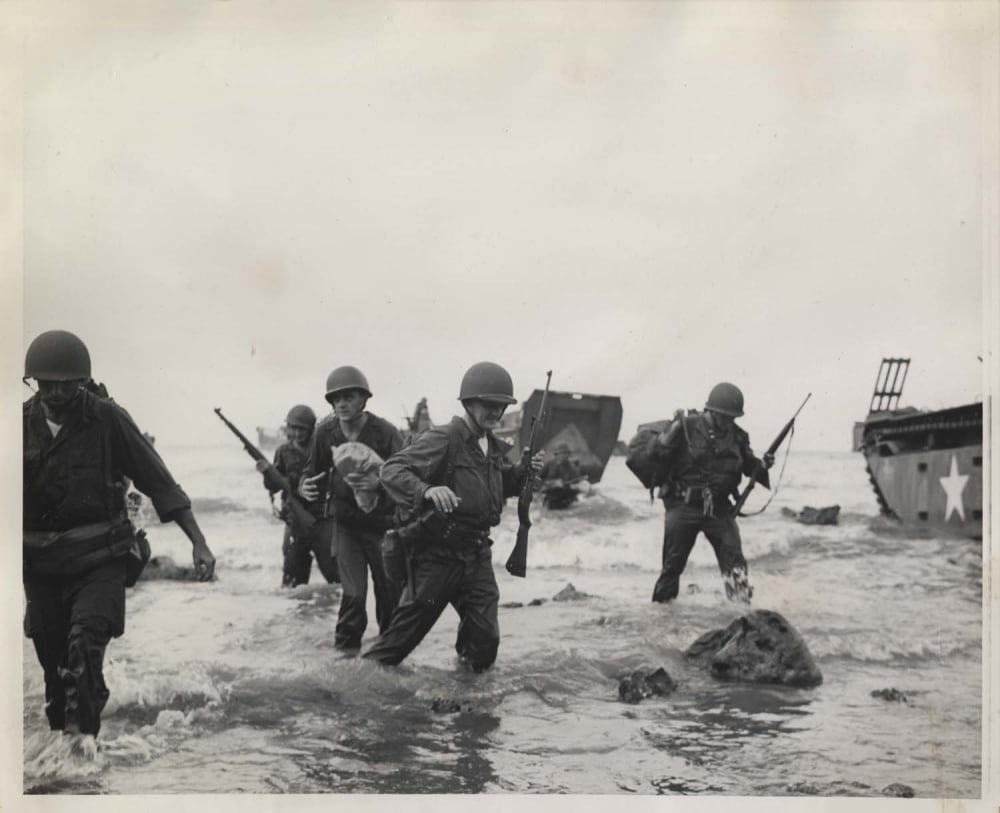
Tank and infantry coordination, while still hampered by poor communications and lack of coordinated training, was improving. Infantry would point out enemy positions to the supporting Lee tanks, cover the tanks as they moved in for close-range fire with their sponson-mounted 75mm and turret-mounted 37mm guns, and mop up the positions once the tanks moved forward.
While the tanks supported the infantry during 2nd Battalion’s advance, most Japanese emplacements were destroyed by squads of engineers and infantry working together. Riflemen and BAR (Browning Automatic Rifle) men would surround a Japanese bunker and fire at the entrances, keeping the defenders inside pinned down. The engineers would move up with charges of TNT attached to poles, which they would shove inside the bunker and detonate, destroying the bunker.
With this slow, steady advance, the 2nd Battalion had pushed 1,000 yards east of Yellow Beach by 1700.
Irked by the 27th Division’s “infuriatingly slow’” advance, Gen. Holland Smith went ashore on the afternoon of Nov. 21 to see what was the matter. Knowing about the savage fighting his Marines were encountering on nearby Tarawa Atoll, at one point Smith suggested to Rear Adm. Turner that the 165th’s 3rd Battalion be sent to Tarawa to help his Marines.
Turner rejected that idea, which added to “Howlin’ Mad” Smith’s irritation at the 27th Division’s slow progress. He was eager to get to Tarawa, where the real trouble was.
Despite his chagrin, Smith toured the Butaritari landing beaches and other areas on the island. After finishing his tour, Smith radioed Turner: “Enemy losses heavy, own slight. Consider situation in hand.”
At the end of the fighting on Nov. 21, the 27th Division had lost 18 killed and 15 wounded.
Ahead lay the east tank barrier.
Shortly after the day’s fighting ended, Col. McDonough’s 2nd Battalion, which had done most of the fighting in the advance from Yellow Beach, was ordered into reserve by Maj. Gen. Ralph Smith. Lt. Col. Joseph Hart’s 3rd Battalion would relieve the 2nd at daybreak and attack eastward.
At 0600 on Nov. 22, the 3rd Battalion moved along Butaritari’s highway toward the area held by 2nd Battalion, while artillery on Ukiangong Point shelled the east tank barrier, firing almost 900 rounds by 0800.
By then the 3rd Battalion had taken over the positions vacated by the 2nd Battalion’s troops. When the artillery barrage lifted, the tanks and infantry moved toward the barrier.
By 0945, 3rd Battalion had reached the east tank barrier, and the artillery resumed firing while the troops waited for the shelling to lift.
While the 3rd Battalion continued its attack, Hart sent a special detachment of two reinforced rifle platoons, a section of light machine guns and a heavy machine-gun platoon in six amtracs to a point on Butaritari’s north shore to cut off the Japanese retreat.
The detachment arrived around noon, landed without opposition and set up a defensive line across the island. As they came ashore, the troops encountered 10 indigenous men who told them that the remaining Japanese were fleeing across eastern Butaritari toward nearby Kuma Island.
The Japanese move played right into Ralph Smith’s hands.
A detachment from the 105th Infantry crossed Makin lagoon in 10 amtracs and landed without opposition near the village of Keuea, a mile from Kuma’s southwestern tip. The soldiers were greeted by friendly villagers “with such gusto,” historian Samuel Eliot Morison observed, “that the troops gave them a joy ride; a fleet of LVTs filled with laughing Gilbertese offered comic relief to a tedious operation.”
More important, the Japanese on Butaritari were cut off.
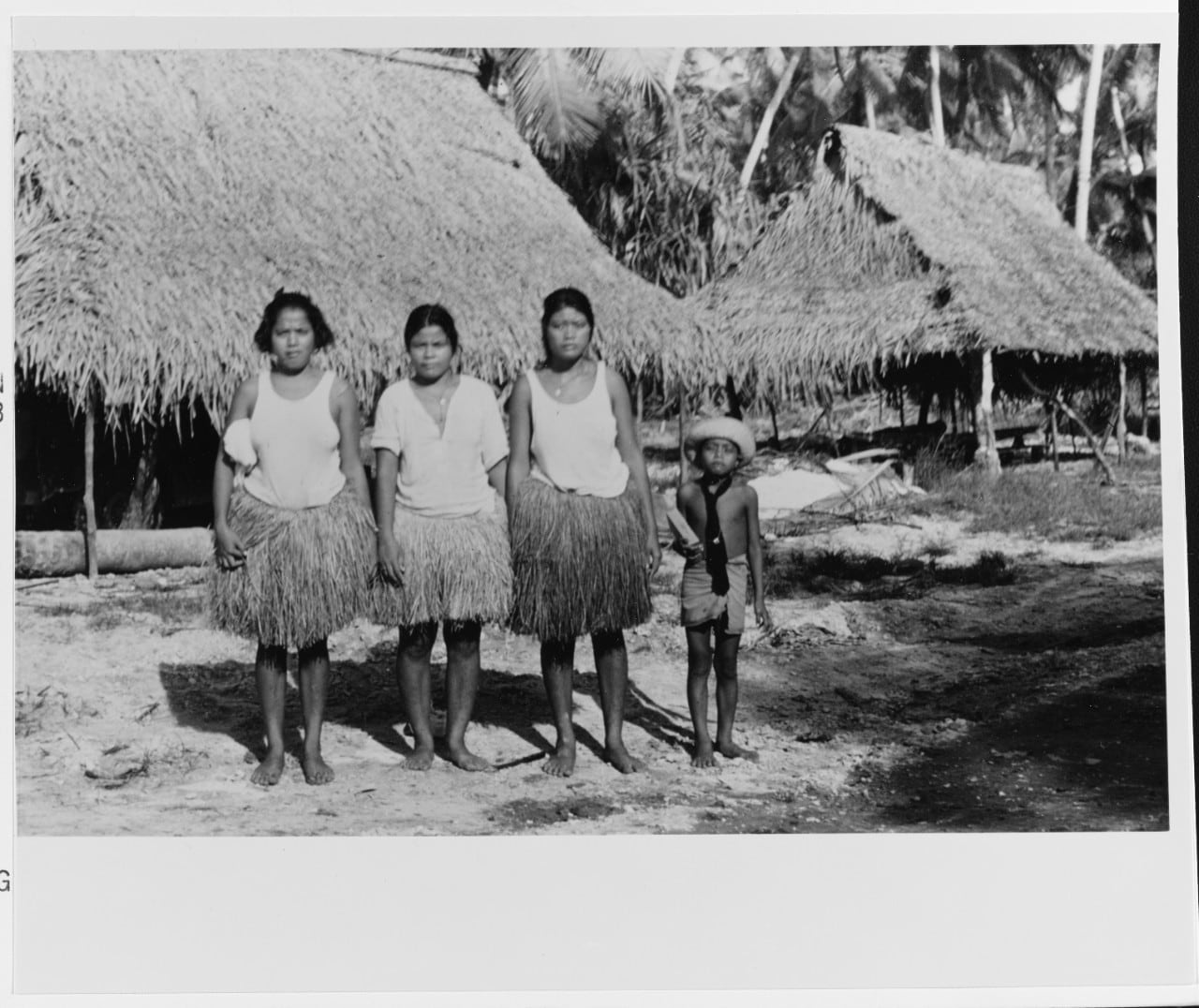
Meanwhile, the 3rd Battalion’s tanks and infantry moved through the east tank barrier. Although stronger than the west tank barrier, this obstacle had been abandoned during the night.
Only a few dead Japanese, killed by the bombardment, were found.
After passing through the barrier, 3rd Battalion’s troops pushed eastward without pause. The 3rd Battalion reached the barricade at 1330 without encountering opposition. The Japanese had slipped eastward before the blocking detachment had arrived.
After a short rest, the 3rd Battalion moved 1,200 yards forward before stopping at 1645 to dig in for the night. The day’s activities had been easy, except for the heat and tangled growth with which the troops had to cope; Japanese resistance beyond the tank barrier had been minimal.
By nightfall, the 3rd Battalion was dug in across Butaritari in a line 300 yards long. The men dug shallow foxholes or built barricades of coconut logs in front of their positions. Few officers or men believed there was much danger from the remaining Japanese.
Shortly after dark, however, the Japanese attacked the 3rd Battalion’s perimeter.
“Many of us had the idea there were no Japs left,” an officer later said. “When the firing began, I didn’t believe it was the real thing.”
There was no organized attack such as the 27th Division would encounter eight months later at Saipan. This was a series of uncoordinated small-unit attacks. The night was broken by firefights, infiltrations and individual attacks on the American positions.
Under the cover of darkness, the Japanese tried every trick in the book. In one instance, a group of Japanese followed some natives passing through American lines, imitating baby cries as they came. A GI machine-gunner recognized the ruse and opened fire, killing 10 Japanese.
The Japanese threw firecrackers and began a tom-tom-like beating to unnerve the Americans; taunts and threats were shouted, and individual soldiers were called by name. A few Japanese under the influence of sake yelled or sang.
The Americans fought off each attack, most of which fell on a few machine-gun and heavy-weapons positions along the front. A few Japanese tried to escape over the reef from Butaritari to Kuma Island but were cut down as they tried to cross.
When daylight came on Nov. 23, 1943, 51 Japanese dead were found in front of the American guns, representing the bulk of the remaining Japanese garrison on Butaritari. All that remained was to secure the rest of the island.
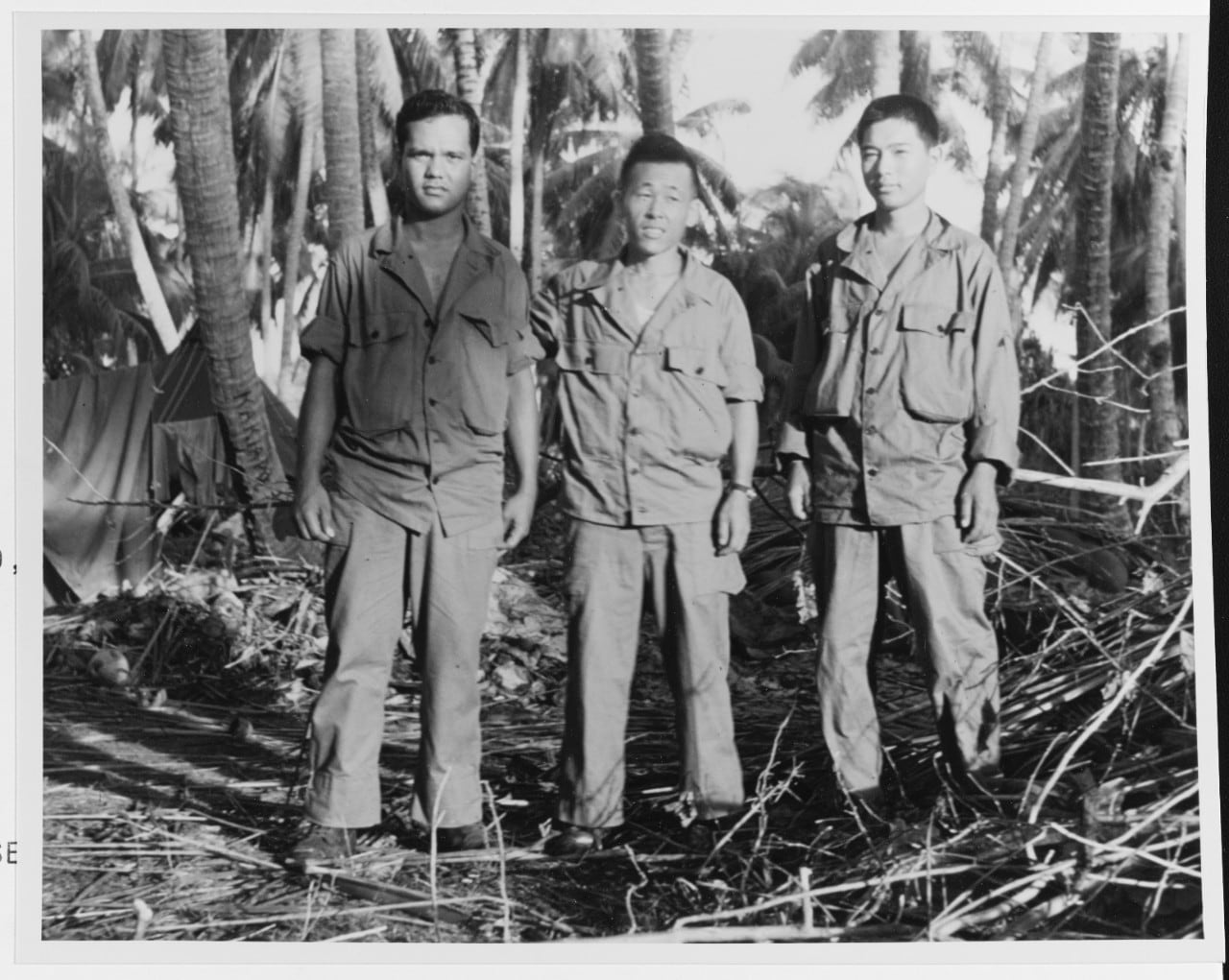
The American attack resumed at 0715, with the 3rd Battalion’s I Company leading the advance and riding on the five Stuart and 16 Lee tanks spearheading the drive, and with Companies K and L on each flank. By 1030, the 3rd Battalion’s advance elements had reached the eastern tip of Butaritari, and organized resistance was declared ended.
Only a few Japanese, mostly labor troops and airmen, were encountered and quickly silenced.
An hour later, Ralph Smith radioed Rear Adm. Turner: “Makin taken.”
In the battle to seize Makin, the 27th Division lost 66 soldiers killed and 152 wounded.
Japanese casualties were 550 men killed and 105 prisoners of war, all but one of whom were labor troops.
When the fighting was over, the 1st and 2nd battalions of the 165th Infantry boarded transports, leaving the 3rd Battalion and other supporting units on Makin to protect Col. Clessen H. Tenney’s garrison force, which arrived the next day.
The remaining troops, along with survivors from the escort carrier Liscombe Bay, which had been sunk off Makin, were aboard the transports and ready to sail at noon on Nov. 24. After a delay caused by reports of Japanese aircraft in the vicinity, the convoy shoved off for the shores of Oahu.
The capture of Makin was history.
RELATED
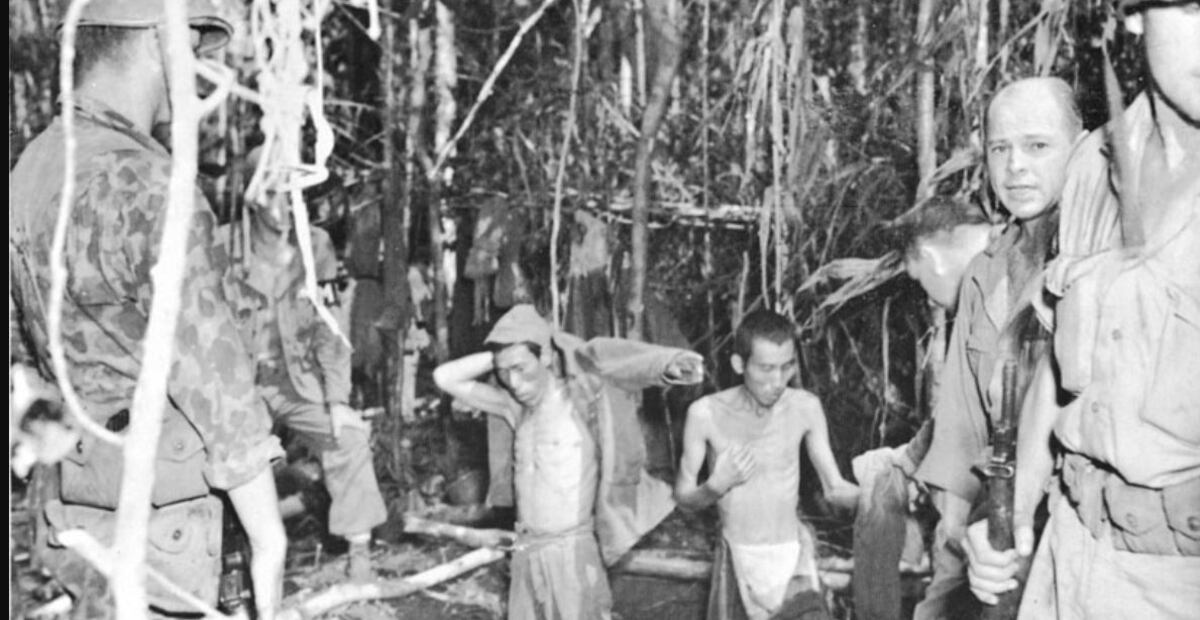
This article was written by William B. Allmon and originally appeared in the November 1999 issue of World War II magazine, a sister publication of Navy Times. For more great articles subscribe to World War II magazine today!





